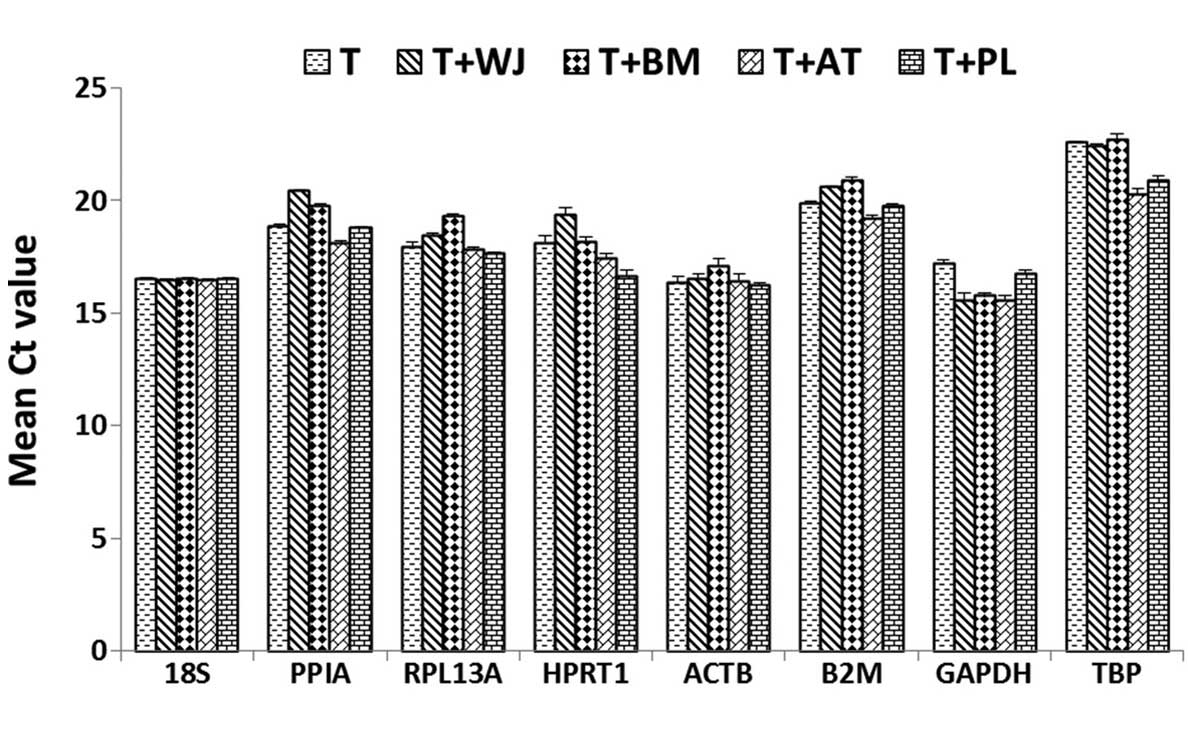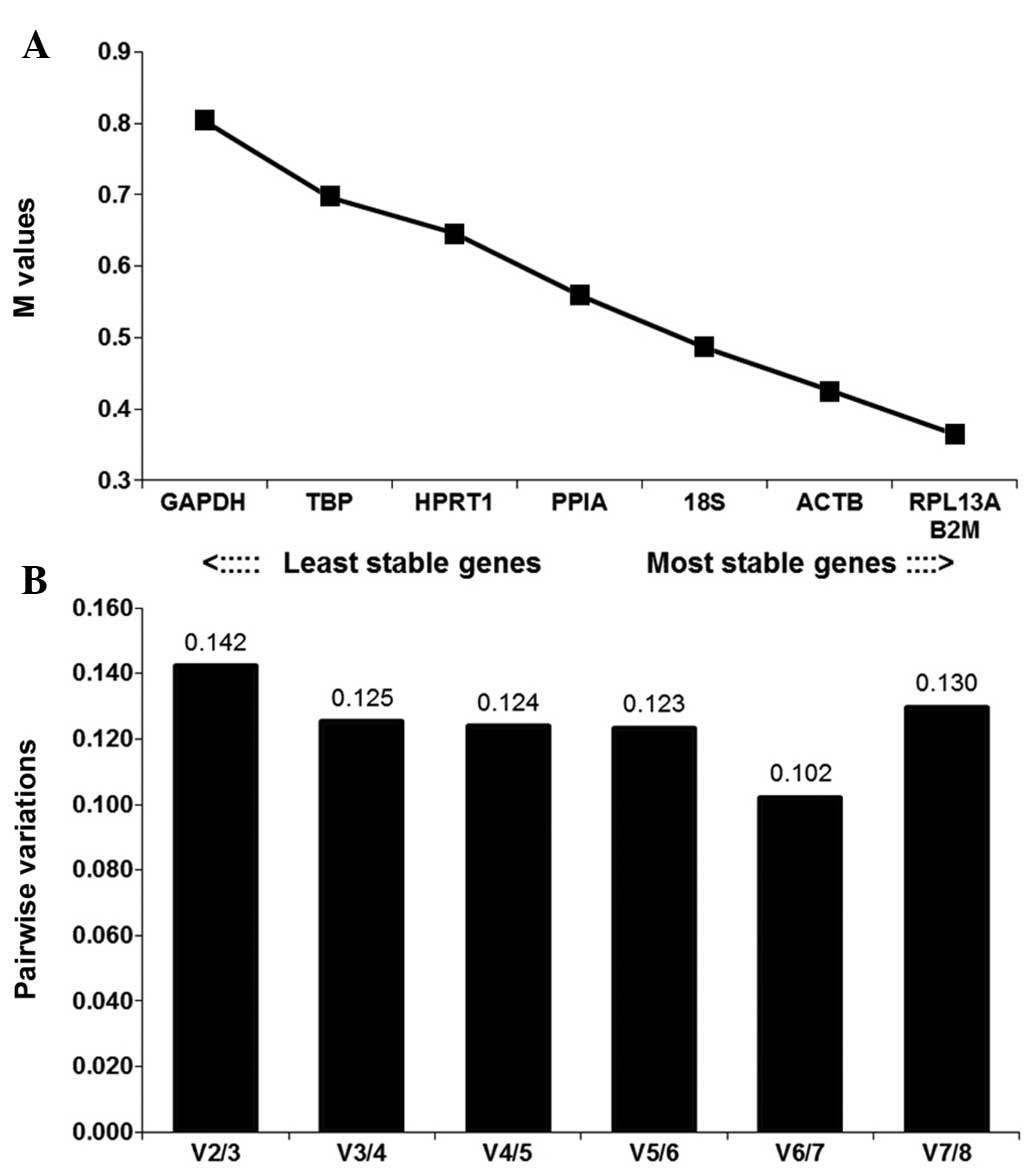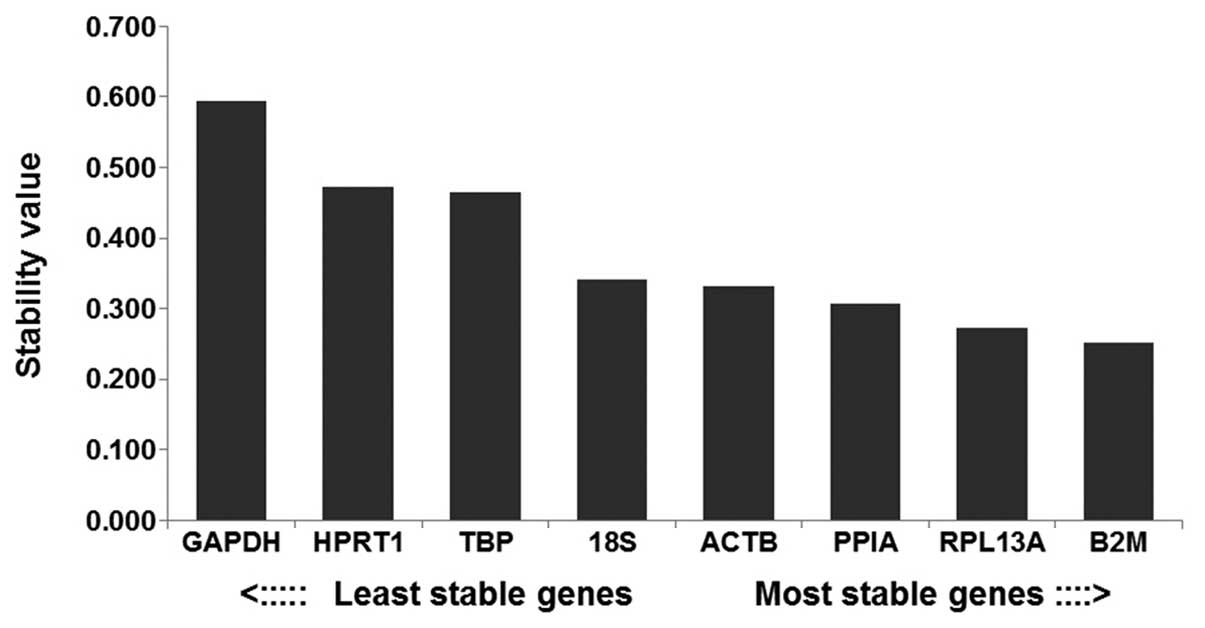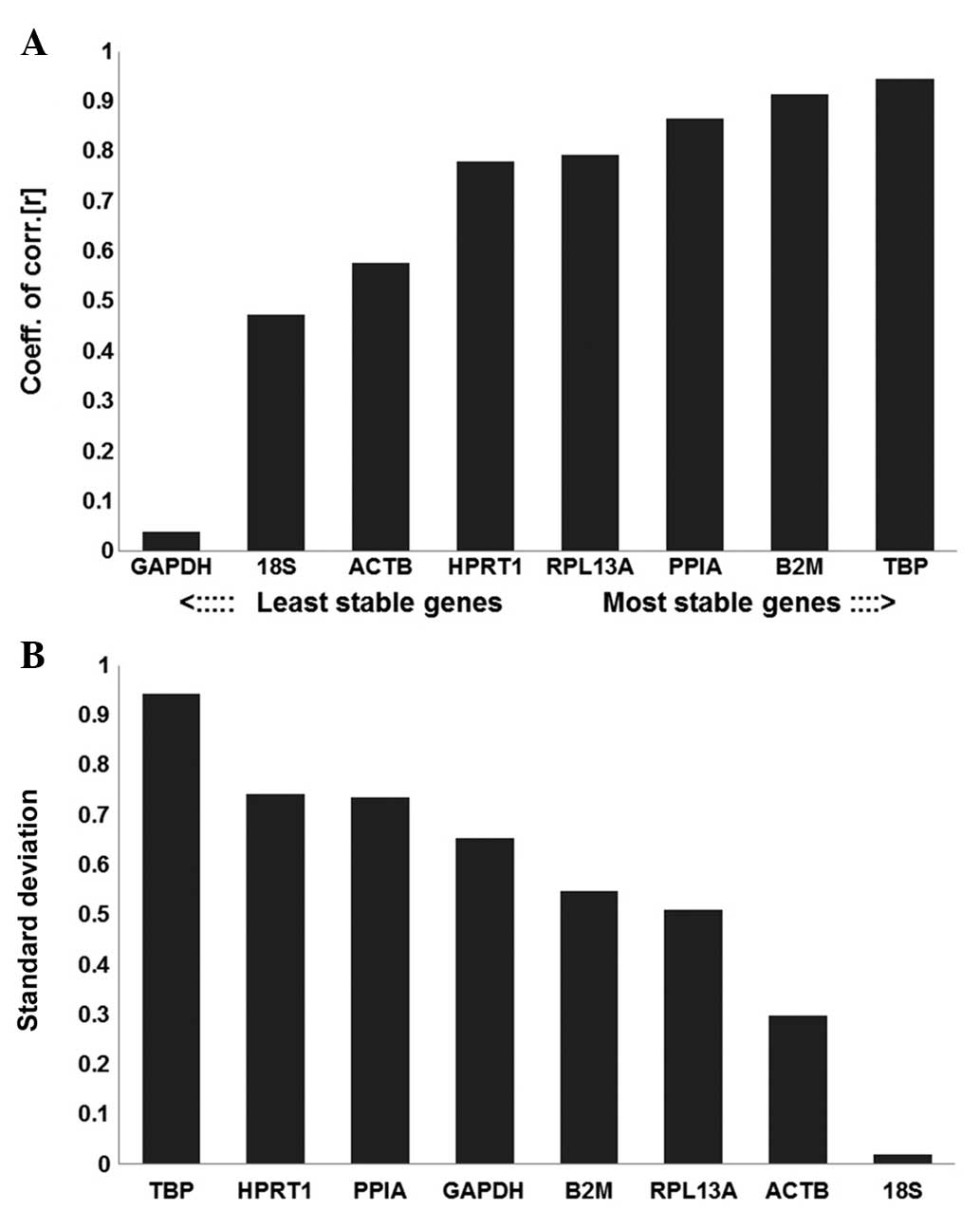Evaluation of eight reference genes for quantitative polymerase chain reaction analysis in human T lymphocytes co‑cultured with mesenchymal stem cells
Corrigendum in: /10.3892/mmr.2021.11920
- Authors:
- Published online on: September 30, 2015 https://doi.org/10.3892/mmr.2015.4396
- Pages: 7721-7727
Abstract
Introduction
Reverse transcription-quantitative polymerase chain reaction (RT-qPCR) is considered the most reliable technique for the detection and quantification of mRNA expression due to its high levels of accuracy and sensitivity (1). However, several lines of evidence have suggested that the expression of reference genes vary between cell types and experimental conditions (2–4). The use of unstable internal controls can lead to incorrect results and erroneous conclusions. Therefore, it is essential to use suitable reference genes as a standard internal control to normalize levels of gene expression (5). An ideal reference gene is that which is unaffected by external or internal factors, including cell type or experimental conditions (6), and they are stably expressed in different samples (7). However, no single reference gene has been reported to exhibit constant expression levels, and there is increasing evidence suggesting that the expression levels of commonly used reference genes, including glyceraldehyde 3-phosphate dehydrogenase (GAPDH) and β-actin (ACTB) vary substantially depending on experimental conditions (3,8). Therefore, it is essential to compare and evaluate the stability of each reference gene prior to its use in experiments.
Human mesenchymal stem cells (MSCs) are highly proliferative, plastic adherent, fibroblast-like cells, which are capable of osteogenic, chondrogenic and adipogenic differentiation (9). MSCs are considered to assist healing, in part via modulation and downregulation of the immune response, including decreasing cytokine-associated acute inflammation and increasing blood flow to promote normal healing, rather than scarring (10). Although the mechanisms underlying the behavior of MSCs during an immune response and their immunomodula-tory effects remain to be elucidated, it is widely-accepted that tissue-derived MSCs exhibit potent immunomodulatory properties, including T lymphocyte, B lymphocyte and natural killer cell suppression (11–13). To further investigate the molecular mechanisms underlying MSC suppression of T lymphocytes, careful selection of an appropriate reference gene is required. To the best of our knowledge, no previous report has described the experimental identification and validation of suitable endogenous controls for the normalization of T lymphocytes co-cultured with MSCs. The present study aimed to identify the most stable endogenous controls for the normalization of the gene expression of T lymphocytes co-cultured with different MSCs. In total, eight common reference genes were selected and used in the present study, and their expression stability was analyzed using the geNorm (14), NormFinder (15) and BestKeeper (16) algorithms.
Materials and methods
Isolation and expansion of MSCs
MSCs were isolated from four human tissue harvest sites: Bone marrow (BM), adipose tissue (AT), umbilical cord Wharton's jelly (WJ) and placenta (PL). Eight BM and AT tissue samples were obtained from healthy donors (age, 18–43 and 23–50 years, respectively), and eight WJ and PL tissue samples were obtained from female patients (age, 23–38 years) following normal birth via caesarean section at the China-Japan Union Hospital, Jilin University (Changchun, China). All patients provided written informed consent, and the present study was approved by the Ethical Committee of the China-Japan Union Hospital, Jilin University. MSCs from the BM, AT, WJ and PL were isolated, using an enzymatid digestion method as previously described (17). Briefly, collagenase and hyaluronidase (Sigma-Aldrich, St. Louis, MO, USA) were used to digest the umbilical cord tissue samples following removal of the outer skin layer. The PL and AT were digested by collagenase only. BM-MSCs were obtained by BM adherence culture. Briefly, the cells were maintained in a humidified incubator containing 5% CO2 at 37°C for 48 h, and non-adherent cells were removed when the media was changed (18). Following processing, the MSCs were plated in a culture flask with α-minimal essential medium (MEM) supplemented with 10% fetal bovine serum (FBS; Gibco Life Technologies, Carlsbad, CA, USA) and 1% penicillin/streptomycin (GE Healthcare Life Sciences, Logan, UT, USA) (17). The culture was maintained at 37°C with saturated humidity in an atmosphere containing 5% CO2.
Co-culture of MSCs and T lymphocytes
Human T lymphocytes were purchased from Guangzhou Jennio Biological Technology Co., Ltd. (Guangdong, China). Co-culture of the MSCs and T lymphocytes was performed using 6-well plates. Briefly, the BM, AT, WJ and PL MSCs were seeded at 5×105 cells/well in regular 6-well plates containing a-MEM supplemented with 10% FBS and 100 U/ml penicillin/streptomycin. After 24 h, 10 µg/ml mitomycin C (Sigma-Aldrich) was added to inhibit MSC proliferation, and the cells were incubated for 2 h at 37°C, followed by five extensive washes with α-MEM. A total of 5×105 T lymphocytes/well were added and stimulated with 10 ng/ml phytohemagglutinin (PHA; Sigma-Aldrich) and 10 ng/ml interleukin (IL)-2 (Sigma-Aldrich). The IL-2/PHA-activated T lymphocytes were subsequently cultured in presence of the MSCs and the T lymphocytes were obtained following incubation for 4 days.
Reference gene selection and primer design
A total of eight commonly-used stable reference genes were selected, including 18S ribosomal RNA (18S), GAPDH, ACTB, peptidyl-prolylisomerase A (PPIA), β-2-microglobulin (B2M), ribosomal protein L13a (RPL13A), hypoxanthinephosphori-bosyl transferase 1 (HPRT1), and TATA box-binding protein (TBP), based on previous studies (19,20). The gene sequences were obtained from GenBank (http://www.ncbi.nlm.nih.gov/genbank/). The full name of the reference genes, primer sequences, accession number, and corresponding amplicon sizes are listed in Table I. Primers were designed using Primer3 (http://flypush.imgen.bcm.tmc.edu/primer/primer3_www.cgi)/All PCR primers were synthesized by Sangon Biotech Co., Ltd. (Shanghai, China), with melting temperatures of 60°C. All primers were purified using ultrapage (Research Scientific Instruments Co., Ltd., Xiamen, China).
RNA extraction and RT-qPCR
Total RNA from the co-cultured T lymphocytes was extracted and RT-qPCR was performed, as previously described (17). Total cellular RNA was extracted using TRIzol® reagent (Invitrogen Life Technologies, Carlsbad, CA, USA) according to the manufacturer's instructions. RNA integrity was electrophoretically verified by ethidium bromide (Sigma-Aldrich) staining and an optical density (OD)260/OD280 nm absorption ratio >1.9. Total RNA (500 ng) was reverse transcribed into cDNA using AWV reverse trancriptase, oligo dT (~20 mer, Takara Biotechnology Co., Ltd., Dalian, China) according to the manufacturer's instructions. A non-amplification control was included without adding reverse transcriptase. The following reaction conditions were used: 42°C for 30 min, then 95°C for 5 min, and 5°C for 5 min. RT-qPCR was carried out using the ABI PRISM 7900 Sequence Detection system (Applied Biosystems Life Technologies, Foster City, CA, USA). A total of 25 ng cDNA was used in the qRT-PCR reactions with SYBR® Green PCR Master Mix (Applied Biosystems Life Technologies), as well as 5 µM of gene-specific forward and reverse primers (Sangon Biotech Co., Ltd.). All PCR products demonstrated a single band by a dissociation curve and gel electrophoresis. The thermocycler (Prism 7900; Applied Biosystems Life Technologies) parameters for the amplification of these genes were as follows: 95°C for 10 min, followed by 40 cycles at 95°C for 15 s, 55°C for 15 s and 72°C for 30 s. To evaluate the efficiency of the PCR, a standard curve was generated using linear regression based on the cycle threshold (CT) values. The PCR amplification products were analyzed using 2% agarose gel electrophoresis (Sigma-Aldrich) and dissociation curves. A single band with anticipate size indicated the PCR product was specific. Each sample, with 10-fold serial dilutions, was plotted against the logarithm of the cDNA dilution factor. An estimation of PCR efficiency was calculated from the slope of the calibration curve using the following equation: Efficiency = [101/−slop−1] x 100%, where slop represents the slope of the linear regression (16). All reactions were performed in triplicate and the data were analyzed using the 2−ΔΔCt method (5).
Reference gene evaluation using the GeNorm, NormFinder and BestKeeper algorithms
The expression stability of the eight reference genes were measured using three commonly used algorithms: geNorm (https://genorm.cmgg.be/), NormFinder (http://moma.dk/normfinder-software/normfinder-faq) and BestKeeper (http://www.gene-quantification.de/bestkeeper.html). These three programs are based on Microsoft Excel and use different algorithms to evaluate the expression stability of reference genes. For geNorm and NormFinder, the Ct values were converted into relative quantities using the 2−(Ct-lowest Ct) formula. For BestKeeper, the Ct values were used directly.
GeNorm analyzes the gene expression stability (M-value) and pair-wise variation (V), with the lowest M-value representing the highest stability. V is calculated to determine the minimal number of reference genes required. If V<0.15, the number of reference genes is sufficient for valid normalization.
NormFinder is based on a variance estimation approach. Higher values indicate lower stabilities. NormFinder is also able to compare inter- and intra-group variations in gene stability.
BestKeeper calculates the expression level variation for reference gene stability based on the standard deviation (SD) and correlation coefficient (r). Genes with SD>1.00 are considered unreliable as reference genes, and the remaining genes are ranked according to their r-values, with the highest r-value indicating the highest stability.
Results
Amplification specificity and primer efficiency
The A260/280 ratio for the isolated RNA was 1.85–2.0. The amplification performance of each primer pair was analyzed using RT-qPCR. The specificity of the PCR products were analyzed using a dissociation curve and 2% agarose gel. No primer/dimers or multibands/peaks were detected, confirming a single amplified band of a predicted size (Fig. 1). All primer pairs exhibited efficiency values ranging between 86.56 and 103.09% (Table I), with correlation coefficients of R2>0.97.
Expression levels of the reference genes
An ideal reference gene is expressed at relatively high and stable levels (21). Figure 2 shows the mean Ct-values for each reference gene in the five samples, indicating the expression levels in the different experimental groups. The eight experimental reference genes exhibited a wide range of expression, with Ct-values ranging between 15.58 for GAPDH and 22.94 for TBP. Among these genes, GAPDH (Ct, 15.58–17.25) and 18S (Ct, 16.54–16.60) exhibited the highest expression levels, and TBP (Ct, 20.32–22.75) exhibited the lowest expression levels in the T lymphocytes. The expression levels of each reference gene was significantly different in all experimental cells, with the smallest difference observed for 18S (ΔCt=0.06) and the most marked difference observed for hypoxanthinephosphoribosyl transferase 1 (ΔCt=2.69).
RPL13A are the most stably expressed reference genes in T lymphocytes co-cultured with MSCs
The average stability M-values of the eight reference genes in the experimental tissue samples are shown in Fig. 3A. According the principles of geNorm, B2M and RPL13A were the most stably expressed genes (M<0.4). GAPDH and TBP were the least stably expressed genes, although their M-values remained <0.9. The V2/3 value, which indicates the pair-wise variation when the number of normalization factors increases between two and three, was 0.142, which was below the cut-off value of 0.15. Therefore, the B2M and RPL13A reference genes were considered sufficiently stable, and addition of the third gene is optional (Fig. 3B).
According to NormFinder, reference genes that are more stably expressed are indicated by lower stability values. The most stable genes identified in the present study were B2M, with a stability value of 0.251. The most unstable genes were GAPDH, HPRT1 and TBP, which exhibited stability values of 0.594, 0.473 and 0.465, respectively (Fig. 4). The ranking of the selected reference genes used in the present study, according to stability was as follows: B2M>RPL13A> PPIA> ACTB>18S>TBP>hypoxanthinephosphoribosyl transferase 1 (HPRT1)>GAPDH. GAPDH was found to be the most unstable reference gene.
The results of the BestKeeper analysis are presented in Table II. GAPDH was the most unstable reference gene and TBP was the most stable reference gene determined by BestKeeper (Fig. 5). These results suggested that TBP, B2M and PPIA were the most stable reference genes, with the highest r-values, whereas GAPDH had the lowest r-value (0.04), reflecting the least stable expression.
Overall, following stability analysis of the eight reference genes using the geNorm, NormFinder and BestKeeper algorithms, geNorm and NormFinder indicated that B2M and RPL13A were the most stable reference genes, and that GAPDH was the least stable reference gene. However BestKeeper demonstrated that TBP and B2M were the most stable reference genes. A summary of the rankings produced by the three algorithms is shown in Table III.
Table IIIRanking of reference gene stability using the geNorm, NormFinder and BestKeeper algorithms. |
Discussion
It is well established that a reference gene requires validation prior to a specific experiment in order to confirm that gene expression is not affected by the experimental conditions. However, increasing evidence suggests that the expression levels of widely-used reference genes vary significantly in independent investigations (3,22). Therefore, it is essential to normalize the expression levels of reference genes, and determine their reliability prior to RT-qPCR analysis. To the best of our knowledge, the present study is the first to investigate the stability of reference genes in T lymphocytes co-cultured with different MSCs.
The results of the present study suggested that the expression of reference genes varied significantly between different cells. Therefore, investigations of gene expression alterations between different cell types requires careful selection of reference genes, which are expressed at similar relative levels between the cell types.
In the present study, the results obtained from the three algorithms, geNorm, NormFinder and BestKeeper, demonstrated discrepancies in the stability ranking of the reference genes. These differences were likely to be caused by the different calculation algorithms used in these software programs (8). According to geNorm, the reference genes with an average M-value expression <1.5 are considered reliable. Therefore, RPL13A and B2M were the most stable reference genes determined by geNorm in the present study. Similarly, the results of NormFinder suggested that B2M was the most stable reference gene, followed by RPL13A. When intergroup variation was taken into consideration, 18S and TBP were revealed as the optimal combination. In addition, the stability value of this combination (0.163) was lower than that of B2M (0.251), indicating that the combination of 18S and TBP as reference genes is sufficiently reliable for relative quantification. Therefore, the number of reference genes also depends on the experimental conditions. BestKeeper identified TBP and B2M as the most stable reference genes. All three algorithms determined GAPDH as the least stable reference gene.
In the present study, GAPDH was confirmed as the least stable reference gene. Another reference gene, ACTB, is frequently used to normalize RT-qPCR data without any prior validation (23). However, ACTB was ranked with low stability in the present study, indicating that it was unsuitable for use in T lymphocytes. The results of the present study demonstrated that the evaluation of reference genes for normalization of RT-qPCR data is essential, and the use of common reference genes, including ACTB and GAPDH, without prior validation may lead to false results.
PPIA has a versatile role as a reference gene in immuno-suppression, being regulated by CD4+ T cells and inducing leukocyte subsets (24–26). It has been suggested that the expression of PPIA is lower in unstimulated T lymphocytes, but may be higher than normal in T lymphocytes stimulated with allergens or MSCs (19). Although the results of the present study did not indicate high expression levels of PPIA in the MSC co-cultured groups, its readily altered characteristics makes PPIA unreliable as a reference gene. Therefore, when the experimental conditions or experimental treatments may lead to a change in the expression levels of the reference gene, this reference gene cannot be used to normalize the results of RT-qPCR.
In conclusion, among the eight genes analyzed in the present study, RPL13A and B2M were identified as the most suitable for analysis of gene expression levels in T cells co-cultured with MSCs, whereas GAPDH is the least stable gene, and is unsuitable for use as an internal control. These findings may also be useful when validating other genes using selected reference genes from T lymphocytes.
Acknowledgments
This study was supported by Jilin university funding from the Tang Ao Qing Distinguished Professorship (Professor Y Wang) (grant no. 450091105188).
References
|
Cikos S and Koppel J: Transformation of real-time PCR fluorescence data to target gene quantity. Anal Biochem. 384:1–10. 2009. View Article : Google Scholar | |
|
Zhong Q, Zhang Q, Wang Z, Qi J, Chen Y, Li S, Sun Y, Li C and Lan X: Expression profiling and validation of potential reference genes during Paralichthys olivaceus embryogenesis. Mar Biotechnol (NY). 10:310–318. 2008. View Article : Google Scholar | |
|
Cordoba EM, Die JV, Gonzalez-Verdejo CI, Nadal S and Román B: Selection of reference genes in Hedysarum coronarium under various stresses and stages of development. Anal Biochem. 409:236–243. 2011. View Article : Google Scholar | |
|
Schmittgen TD and Zakrajsek BA: Effect of experimental treatment on housekeeping gene expression: Validation by real-time, quantitative RT-PCR. J Biochem Biophys Methods. 46:69–81. 2000. View Article : Google Scholar : PubMed/NCBI | |
|
Dheda K, Huggett JF, Bustin SA, Johnson MA, Rook G and Zumla A: Validation of housekeeping genes for normalizing RNA expression in real-time PCR. Biotechniques. 37:112–114. 2004.PubMed/NCBI | |
|
Radonić A, Thulke S, Mackay IM, Landt O, Siegert W and Nitsche A: Guideline to reference gene selection for quantitative real-time PCR. Biochem Biophys Res Commun. 313:856–862. 2004. View Article : Google Scholar | |
|
Suzuki T, Higgins PJ and Crawford DR: Control selection for RNA quantitation. Biotechniques. 29:332–337. 2000.PubMed/NCBI | |
|
Chang E, Shi S, Liu J, Cheng T, Xue L, Yang X, Yang W, Lan Q and Jiang Z: Selection of reference genes for quantitative gene expression studies in Platycladus orientalis (Cupressaceae) Using real-time PCR. PLoS One. 7:e332782012. View Article : Google Scholar : PubMed/NCBI | |
|
Pittenger MF, Mackay AM, Beck SC, Jaiswal RK, Douglas R, Mosca JD, Moorman MA, Simonetti DW, Craig S and Marshak DR: Multilineage potential of adult human mesen-chymal stem cells. Science. 284:143–147. 1999. View Article : Google Scholar : PubMed/NCBI | |
|
Tomic S, Djokic J, Vasilijic S, Vucevic D, Todorovic V, Supic G and Colic M: Immunomodulatory properties of mesenchymal stem cells derived from dental pulp and dental follicle are susceptible to activation by toll-like receptor agonists. Stem Cells Dev. 20:695–708. 2011. View Article : Google Scholar | |
|
Ramasamy R, Tong CK, Seow HF, Vidyadaran S and Dazzi F: The immunosuppressive effects of human bone marrow-derived mesenchymal stem cells target T cell proliferation but not its effector function. Cell Immunol. 251:131–136. 2008. View Article : Google Scholar : PubMed/NCBI | |
|
Che N, Li X, Zhou S, Liu R, Shi D, Lu L and Sun L: Umbilical cord mesenchymal stem cells suppress B-cell proliferation and differentiation. Cell Immunol. 274:46–53. 2012. View Article : Google Scholar : PubMed/NCBI | |
|
Spaggiari GM, Capobianco A, Becchetti S, Mingari MC and Moretta L: Mesenchymal stem cell-natural killer cell interactions: Evidence that activated NK cells are capable of killing MSCs, whereas MSCs can inhibit IL-2-induced NK-cell proliferation. Blood. 107:1484–1490. 2006. View Article : Google Scholar | |
|
Vandesompele J, De Preter K, Pattyn F, Poppe B, Van Roy N, De Paepe A and Speleman F: Accurate normalization of real-time quantitative RT-PCR data by geometric averaging of multiple internal control genes. Genome Biol. 3:RESEARCH00342002. View Article : Google Scholar : PubMed/NCBI | |
|
Andersen CL, Jensen JL and Ørntoft TF: Normalization of real-time quantitative reverse transcription-PCR data: A model-based variance estimation approach to identify genes suited for normalization, applied to bladder and colon cancer data sets. Cancer Res. 64:5245–5250. 2004. View Article : Google Scholar : PubMed/NCBI | |
|
Pfaffl MW, Tichopad A, Prgomet C and Neuvians TP: Determination of stable housekeeping genes, differentially regulated target genes and sample integrity: BestKeeper-Excel-based tool using pair-wise correlations. Biotechnol Lett. 26:509–515. 2004. View Article : Google Scholar : PubMed/NCBI | |
|
Li X, Bai J, Ji X, Li R, Xuan Y and Wang Y: Comprehensive characterization of four different populations of human mesenchymal stem cells as regards their immune properties, proliferation and differentiation. Int J Mol Med. 34:695–704. 2014.PubMed/NCBI | |
|
Meirelles Lda S and Nardi NB: Murine marrow-derived mesenchymal stem cell: Isolation, in vitro expansion, and char-acterization. Br J Haematol. 123:702–711. 2003. View Article : Google Scholar : PubMed/NCBI | |
|
Mane VP, Heuer MA, Hillyer P, Navarro MB and Rabin RL: Systematic method for determining an ideal housekeeping gene for real-time PCR analysis. J Biomol Tech. 19:342–347. 2008. | |
|
Wang T, Liang ZA, Sandford AJ, Xiong XY, Yang YY, Ji YL and He JQ: Selection of suitable housekeeping genes for real-time quantitative PCR in CD4 (+) lymphocytes from asthmatics with or without depression. PloS One. 7:e483672012. View Article : Google Scholar | |
|
Huggett J, Dheda K, Bustin S and Zumla A: Real-time RT-PCR normalisation; strategies and considerations. Genes Immun. 6:279–284. 2005. View Article : Google Scholar : PubMed/NCBI | |
|
Schmittgen TD and Zakrajsek BA: Effect of experimental treatment on housekeeping gene expression: Validation by real-time, quantitative RT-PCR. J Biochem Biophys Methods. 46:69–81. 2000. View Article : Google Scholar : PubMed/NCBI | |
|
Najar M, Raicevic G, Boufker HI, Fayyad Kazan H, De Bruyn C, Meuleman N, Bron D, Toungouz M and Lagneaux L: Mesenchymal stromal cells use PGE2 to modulate activation and proliferation of lymphocyte subsets: Combined comparison of adipose tissue, Wharton's Jelly and bone marrow sources. Cell Immunol. 264:171–179. 2010. View Article : Google Scholar : PubMed/NCBI | |
|
Colgan J, Asmal M, Neagu M, Yu B, Schneidkraut J, Lee Y, Sokolskaja E, Andreotti A and Luban J: Cyclophilin A regulates TCR signal strength in CD4+ T cells via a proline-directed conformational switch in Itk. Immunity. 21:189–201. 2004. View Article : Google Scholar : PubMed/NCBI | |
|
Arora K, Gwinn WM, Bower MA, Watson A, Okwumabua I, MacDonald HR, Bukrinsky MI and Constant SL: Extracellular cyclophilins contribute to the regulation of inflammatory responses. J Immunol. 175:517–522. 2005. View Article : Google Scholar : PubMed/NCBI | |
|
Damsker JM, Bukrinsky MI and Constant SL: Preferential chemotaxis of activated human CD4+ T cells by extracellular cyclophilin A. J Leukoc Biol. 82:613–618. 2007. View Article : Google Scholar : PubMed/NCBI |














